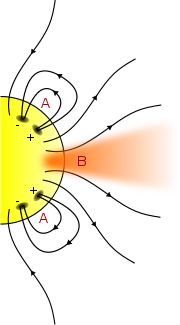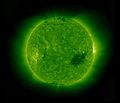Coronal hole

A coronal hole is an area of the solar corona that has a lower temperature and density than its surroundings; the density is typically reduced by a factor of 100. Coronal holes manifest themselves on satellite images in the X-ray range as darker areas.
Their occurrence is more frequent during the fading and in the minimum of the sunspot cycle and represents the main influencing factor for the ionosphere and the magnetic field of the earth during this time . During the sunspot minimum, the spatial occurrence of coronal holes is mostly limited to the pole regions, during the maximum however, they can form at all latitudes .
Emergence
Normally the magnetic field lines in the equatorial area of the sun are closed and thus prevent the plasma from freely escaping into the interplanetary space . However, the sun has pronounced local magnetic field structures, so that it can happen that areas of the same magnetic polarity are close together and the magnetic field lines extend far into the room. The plasma is held within the magnetic field arc, but outside the arc it can escape unhindered as a fast solar wind into the interplanetary space in the areas where the magnetic field lines fall almost perpendicularly back to the sun .
Magnetic field arcs and rapid solar wind escaping from a coronal hole.
Web links
- Solar Terrestrial Activity Report: Coronal hole history (history of coronal holes) [2]
Individual evidence
- ↑ a b David Darling: The Internet Encyclopedia of Science Archived copy ( Memento of the original from September 20, 2008 in the Internet Archive ) Info: The archive link has been inserted automatically and has not yet been checked. Please check the original and archive link according to the instructions and then remove this notice.
- ↑ Aurora Beacon DK0WCY: Coronal holes [1]

